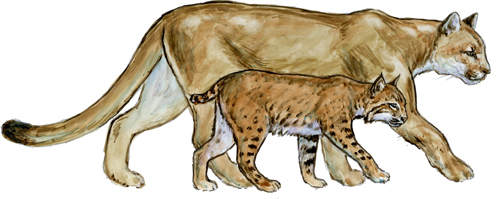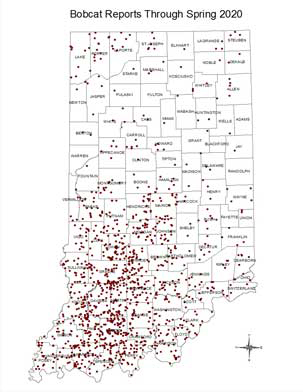Bobcat or Mountain Lion?

Illustration courtesy of Missouri Department of Conservation.
Bobcat
- Weight: 15-30 pounds
- Length: About 30-50 inches long
- Tail: About 4-5 inches long
Mountain Lion
- Weight: 80-160 pounds
- Length: About 7-8 feet long
- Tail: 2-3 feet long (up to half of the total length
Report a Large Mammal Sighting in Indiana
The Indiana Division of Fish & Wildlife occasionally receives reports of large carnivores such as mountain lions, gray wolves and black bears.
There are currently NO breeding populations of these species in Indiana. But one of these animals may pass through Indiana from established populations in other states.
You can report a sighting of these animals online.
Though not a large mammal, bobcats may also be reported online.
Distribution and Abundance
Bobcats have been reported from almost every Indiana county but are most common in southern and west-central Indiana. A study conducted by the DNR in south-central Indiana revealed that bobcats are capable of dispersing up to 100 miles from where they were born.  The DNR collects reports of bobcat sightings, trail-camera photos, and mortalities. Bobcat reports are also collected through the annual Archer’s Index, in which volunteer deer bow hunters report the number of hours they hunted and the species they saw while hunting. Snapshot Indiana, a citizen-science trail-camera survey, also helps document bobcat presence in some areas.
The DNR collects reports of bobcat sightings, trail-camera photos, and mortalities. Bobcat reports are also collected through the annual Archer’s Index, in which volunteer deer bow hunters report the number of hours they hunted and the species they saw while hunting. Snapshot Indiana, a citizen-science trail-camera survey, also helps document bobcat presence in some areas.
Bobcats prefer forested areas that have brushy areas, fields, or clear cuts that are beginning to regrow mixed in. Female bobcat home ranges may vary from 6–12 square miles, and male bobcat home ranges may vary from 30–75 square miles. Bobcats are primarily nocturnal, hunting and moving during early-morning and late-evening hours; however, seeing a bobcat during the day is not cause for concern.
Food Habits
Indiana research has documented bobcat diets to include:
- Rabbits
- Mice and voles
- Squirrels
- White-tailed deer, especially fawns
- Muskrats
- Waterfowl and songbirds
Indiana research did not document wild turkey consumption by bobcats, though bobcats would eat a wild turkey if they manage to catch one. Wild turkey does not seem to be a common prey item for Indiana bobcats.
Reproduction
Management and Control
As with all wildlife, bobcats should be respected if encountered. The natural response of a bobcat is to move away from humans. Bobcats, like all wildlife, should never be fed or approached because doing so can reduce their natural response to avoid people and lead to negative interactions. Removing potential attractants that attract rodents, like pet food or bird feeders, can help encourage a bobcat that is hanging around a yard to move on.
Pets should always be leashed when outdoors or kept in a kennel with a secure top to prevent negative interactions with all wildlife, including bobcats. Conflicts between bobcats and livestock are uncommon but may occur. Most reports are of bobcat predation on chickens. Landowners or lessees may request a nuisance wild animal control permit from the DNR for bobcats if damage is occurring. Landowners or lessees may also hire a nuisance wildlife control operator to assist them if they are not comfortable removing the bobcat themselves. Bobcats may not be removed without a permit.
